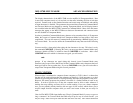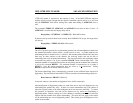
MFJ-1278B MULTI-MODE ADVANCED OPERATION
The wait time is set by the command DWAIT, which specifies 40 ms intervals. If no
digipeating is being done by anyone in the local area, this parameter can be set to 0, but in
any event it should be set to the same value by all members of a local packet group.
In order to avoid unnecessary packet retries, the MFJ-1278B implements a collision-
avoidance strategy which applies to all packets except those being digipeated. On the second
and subsequent transmissions of a particular packet, the MFJ-1278B waits an additional
random time after detecting a clear channel before beginning transmission. This prevents re-
peated collisions of transmissions by the same two stations. The random time is a multiple
(0-15) of the TXDELAY time.
The interval, in milliseconds, between the MFJ-1278B detecting carrier-drop and beginning
to transmit is
Wait time = DWAIT * 10
for the first transmission of a packet. For subsequent transmissions of the same packet the
interval is
Wait time = DWAIT * 10 + ( r * TXDELAY ) * 10
where r is a random number from 0 to 15. Thus, if your MFJ-1278B is forced to re-transmit
packets, you will occasionally hear a fairly long delay before transmission begins.
Multiple packets may be transmitted before waiting for an acknowledgment. This permits
more efficient channel use when large amounts of data are being transferred. The maximum
number of packets which the MFJ-1278B will send before waiting for acknowledgment is
specified by the command MAXFRAME. This does not mean that the MFJ-1278B will wait
until several packets have been entered before transmitting. MAXFRAME in combination
with the command PACLEN, which sets the maximum number of characters in a packet,
determines how much information can be sent in a single transmission. The best combination
for efficient data transfer is determined partly by the channel quality and partly by the rate at
which the terminal can process data. For a 1200 baud terminal data rate, you should start
with a combination that produces about 300 characters outstanding at one time.
Radio Baud Rate
The radio data transmission rate is software selectable for 300 baud and 1200 baud. External
modem (if installed) can also be selected thru software command.
Note that there is no relationship between terminal baud rate and radio baud rate. In order to
communicate with another packet station you must use the same radio baud rates. The length
of time required to send a given amount of information increases as the baud rate decreases.


















